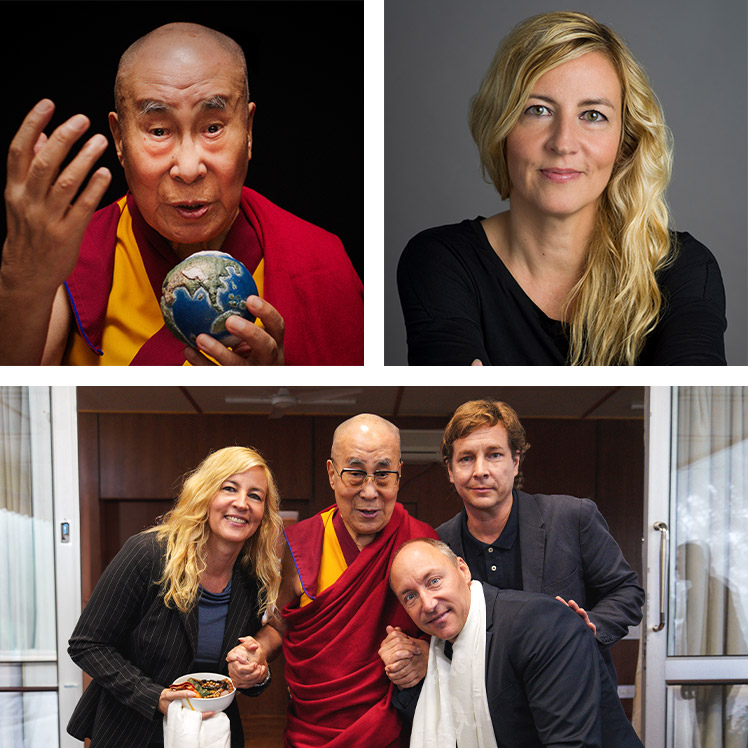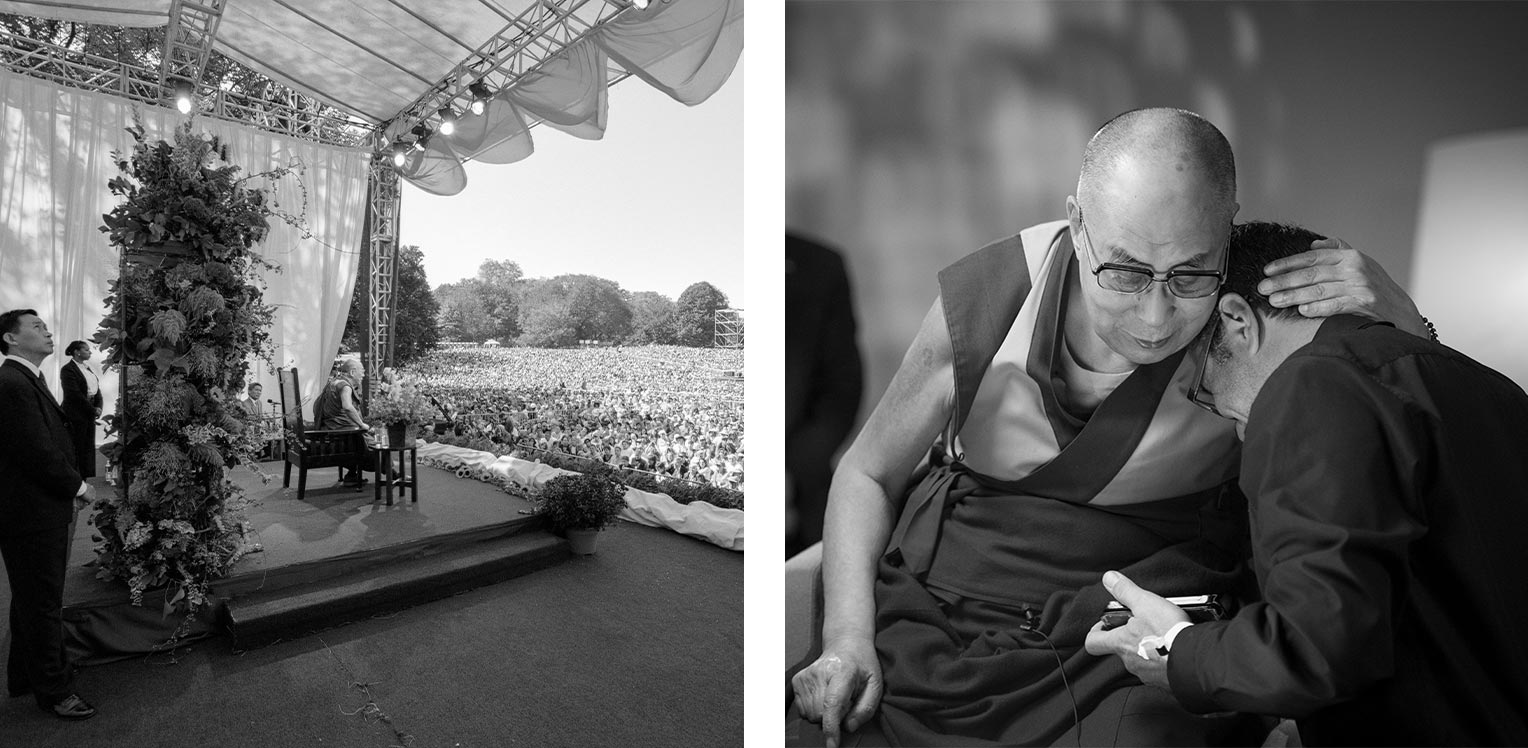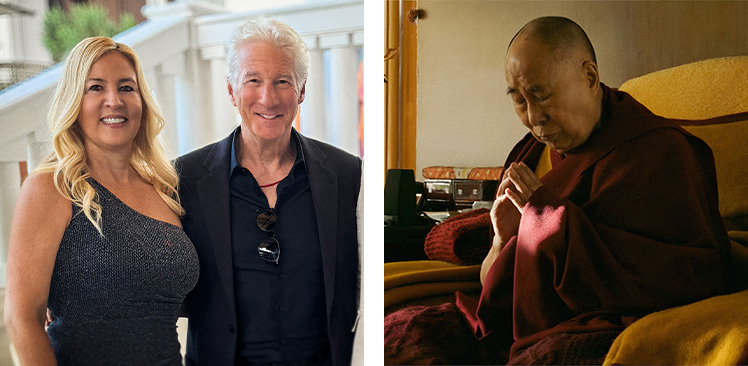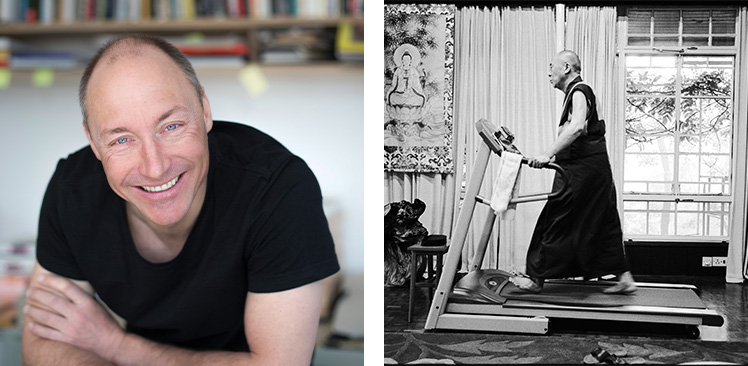A JOURNEY TO THE SOURCE OF HUMANITY
At nearly 90 years old, the Dalai Lama reflects on some of the most pressing issues of our time: climate change, societal divisions, and the seemingly insurmountable challenges of a world on the brink of overwhelming itself. Yet, rather than staring into the abyss with resignation, he sketches a vision of compassion, tranquility, and personal responsibility. His guiding principle: The happiness of the world lies in our hands.
Miller and her team, including producers Philip Delaquis and Richard Gere, weave personal insights, historical archive footage, and stunning visuals of our planet into a meditative journey. At 89, the Dalai Lama addresses the audience with a remarkable sense of intimacy and directness. Guided by Manuel Bauer's cinematography, the camera captures every subtle expression on his face, every nuance of his humor and concern – so vividly personal that one might feel the Dalai Lama is sitting right before them. Barbara Miller, renowned for her bold and socially critical works such as #Female Pleasure, has created a film that is simultaneously contemplative and political, quiet yet powerful. But how does a filmmaker approach a figure who has been portrayed countless times? How can a universal message be conveyed in a world increasingly shaped by cynicism and resignation? These and other questions were explored during an interview with Sabine Kühlwetter Meiers, editor-in-chief of AVIAIR. We met the director at the Berlin premiere and later visited her in Zurich, where we had the chance to discuss her latest masterpiece – a conversation that left us inspired and deeply connected to this remarkable woman.
AVIAIR: Ms. Miller, making a fi lm about the Dalai Lama sounds like a lifetime project. Can you remember when the idea for this project first came to you?
BARBARA MILLER: Oh, I can pinpoint that quite well. It was one of those ideas that take a long time to mature. The thought of doing something with the Dalai Lama had been in my mind for ages, but it always felt more like a dream than a concrete plan. I mean, how oft en does one get the chance to work directly with someone like him? The real catalyst came when I spoke with Manuel Bauer, his longtime photographer. Manuel has a very special connection with the Dalai Lama – he's known him for decades, accompanied him on countless trips, and experienced both the public and private sides of him. We were discussing what might remain once the Dalai Lama is no longer here. Manuel said, "You know, Barbara, it's not about him as a person. It's about his message." That was the moment the idea became more tangible – not a film about the Dalai Lama, but one that conveys his wisdom and worldview. A piece that endures, a legacy that remains relevant for the future.
But how do you approach a figure like the Dalai Lama? Where do you even start?
That was definitely one of the biggest challenges. The Dalai Lama isn’t just a historical figure or a religious icon; he’s also someone incredibly multifaceted. I wanted to move beyond the usual clichés people associate with him – the smiling face, the red robe, the peaceful gestures. Our guiding question was: What does he have to say to us today, in a world often marked by chaos and uncertainty? What can we learn from him that could help us in our daily lives? Of course, gaining access wasn’t easy. The Dalai Lama no longer gives lengthy interviews and is incredibly busy. But that’s where Manuel Bauer came in. He didn’t just open doors but also helped build trust. Without him, this project probably wouldn’t have happened.
Trust must be critical for a project like this.
I remember it clearly. It was 2019 in Zurich, during one of his visits. We had the opportunity to present our concept to him in person. Naturally, I was nervous – I mean, how often does one meet someone like him? But the moment he entered the room, that nervousness just vanished. The Dalai Lama has this incredible ability to instantly put people at ease. He greets you with a smile, looks you straight in the eye, and might even take your hand. In that moment, it feels like everything else around you just fades away. I remember him listening to us and then, with his soft but firm voice, saying, "If this film can help people learn about compassion, then let’s do it." It wasn’t just a yes; it was almost a mission statement. The real work began after that meeting. We had to develop a concept that met his expectations but also worked cinematically. One of the first decisions we made was to avoid making a classic biography. This wasn’t going to be a chronological account of his life but rather a dialogue with the audience. A central element was the interview we planned with him. But that was easier said than done. As I mentioned, the Dalai Lama no longer gives long interviews, especially not in English. It was a delicate balance between respecting his time and getting enough material for the film.
How did you overcome that challenge?
With a lot of patience and an incredible team. We were lucky to have Manuel Bauer, who repeatedly opened doors for us. He not only facilitated connections but also helped us navigate cultural and logistical nuances. A key moment was when we were allowed to meet the Dalai Lama in his private quarters in Dharamsala. That was something truly special because these rooms are normally off-limits to the public.

In the film, it’s just the Dalai Lama speaking directly to the audience. That creates a very intimate setting. Was the interview itself as personal as it seems?
Yes, it really was like a oneonone conversation. Technically, it was an interview, but the camera angles and the use of mirrors create the illusion that he’s looking directly at the viewer. In reality, he was looking at me. We only had three days to set up in his private quarters. Just imagine – he lives under incredibly tight security because his life has been in danger ever since he fled Tibet.
That sounds like a massive undertaking.
It was. But there were so many extraordinary moments that made it all worthwhile. I especially remember the first day when the Dalai Lama entered the room. He greeted everyone, shook hands with each person, and even joked with our sound technician, who had these impressive sideburns. The Dalai Lama pointed at them and said, "Ah, a king from the 18th century!" Everyone laughed, and the tension disappeared instantly. There were also deeply moving moments. For instance, he spoke in a quiet moment about his mother and how much she influenced him. He called her the "guru of compassion" and said that much of who he is today stems from her love and patience. Those are moments you never forget.
Besides the Dalai Lama, Richard Gere plays an important role in the film. How did that collaboration come about?
Richard Gere has been a close friend and student of the Dalai Lama for decades. He’s deeply committed to the Tibetan cause and recognized early on how important it is to preserve Tibetan culture and its message. After we had a rough cut of the film, the Dalai Lama’s secretary showed it to Richard. His reaction was overwhelming. He said, "This isn’t just a film; it’s a message the world needs to hear."
And he was immediately on board?
Yes, but not just as a supporter. Richard wanted to be actively involved. He brought in ideas, helped refine the message, and even suggested adding extra scenes. One example: He insisted on highlighting the vulnerability of the young Dalai Lama more prominently. There’s a scene where the Dalai Lama talks about being disciplined harshly as a child. Richard said, "People need to see that he, too, faced challenges and had weaknesses. It makes him even more extraordinary."

The film includes many historical clips. How did you find those?
hat was an adventure in itself. There’s a massive archive in Dharamsala, but much of it hadn’t been digitized. Some of the film reels were in terrible condition – moldy or damaged. We were able to bring the material to Switzerland for restoration. It felt like a journey through time. I was particularly struck by footage from the 1950s when the Dalai Lama was still in Tibet. Those images depict a world that almost feels mythical today – and they make the loss the Tibetan people have suffered all the more tangible.
The film doesn’t just portray the Dalai Lama; it also carries a message for today’s world. What do you hope viewers will take away?
The Dalai Lama says, "Happiness lies in your own hands." If the film inspires people to reflect on their own lives, on compassion and responsibility, then we’ve achieved our goal. His outlook is incredibly modern and goes far beyond religion. He says, "It’s not about faith; it’s about humanity." And I think that’s something we all need, especially in a world often shaped by fear and uncertainty.
Barbara Miller’s profound insights into the creation and intention of Wisdom of Happiness are enriched by another influential voice: Richard Gere. The Hollywood star, a long-time companion of the Dalai Lama and the film’s executive producer, brings a unique personal touch to this project. His spiritual connection and dedication to the Tibetan cause add an additional layer to Wisdom of Happiness that resonates far beyond the screen.
RICHARD GERE ON SPIRITUALITY, RESPONSIBILITY & THE MESSAGE OF THE FILM
When did you meet the Dalai Lama for the first time, and what impact did this encounter have on your life?
RICHARD GERE: I first met His Holiness the Dalai Lama in 1982. I had been studying Buddhism for some time, mostly with Zen Masters. Japanese was my orientation, but I became fascinated with the Tibetan lineage. I had a letter of introduction to meet His Holiness in Dharamsala, Northern India, where he continues to live after his 1959 escape from the Chinese invasion of Tibet. The meeting was momentous. His compassion, his wisdom, his insight into people, his insight into me were all very powerful — even though he’s completely down to earth and normal, whatever that is. I’ve been his student for almost 45 years now, so obviously he’s had an enormous impact on me.
Why did you decide to contribute your knowledge to WISDOM OF HAPPINESS and become part of the film team?
I saw a rough cut of the film and felt that it was extraordinary footage. What it was trying to do was vast, but also very personal. I had never seen footage of His Holiness looking directly into the camera and sharing his worldview like that. Amazing footage.
I found the movie to be bold and adventurous in its approach, trying to tell the story of His Holiness, of Buddhism and our questions about creating happiness for ourselves and others. But I also felt that my knowledge of His Holiness and my many decades of involvement with Buddhism could be of some help. So they asked me and I said yes.
Then I brought in Oren Moverman, the director, writer and producer who is my longtime friend and collaborator. He was also very moved by what he saw, and we both jumped in and started re-editing, adding new material, and honing the message to clarify some things. We had a wonderful time working on this.
I think there’s a real need for us to reacquaint ourselves with a vaster understanding of who we are as individuals, what reality is, and how we’re all trying to achieve some degree of happiness, if not complete or absolute happiness. And there are ways to do that. Buddhism teaches this. The Dalai Lama teaches this. And I think throughout his life, despite the problems he’s faced for himself and his people, he has maintained his openness and his composure and his vast commitment to help all beings. He doesn’t see anyone as an enemy. We’re all in this together.

When people ask you about Buddhism and the Dalai Lama’s wisdom, are there any aspects you consider to be most helpful?
Certainly. I think what the Buddha offered us 2,500 years ago was an exploration of the question, “Is there a self? What is this thing we take to be our self?” There’s this whole cloud of self-cherishing that forms a protective cocoon around the self we take for granted. But through Buddhist practice and a courageous exploration of that assumed self, we discover that it cannot really be found or is somehow empty of inherent existence. Sure, it has a kind of existence — but ultimately it cannot be found.
Now, from the point of view of Buddhism and His Holiness, there’s a path you can follow to break free from the hallucination that we normally take for reality. It can dissolve that hallucination until we expand to the size of the universe and recognize how we live in a relative world with other beings. We can achieve that kind of vastness if we do the work. The Buddha laid out a path to that vast openness of freedom, of liberation and bliss. And the Dalai Lama reinforces it and shows how it’s possible in our lifetime — but again, you have to do the work. It’s your responsibility to achieve your own happiness.
There’s a famous work by Je Tsongkhapa called “Liberation in the Palm of Your Hand.” That’s what His Holiness always says: “Your liberation is in the palm of your own hands.” It’s really important, a message for us all: We’re responsible for our experience of ourselves and the world.
YOUR LIBERATION IS IN THE PALM OF YOUR OWN HANDS.
His Holiness the Dalai Lama
What long-term impact do you wish for the film to have on Tibet and humanity?
Obviously, Tibetans are living in a martial state right now. It’s extremely diffi cult for anyone to get into the country and see what’s going on. A journalist friend once told me “it’s easier to get into North Korea than Tibet.” It’s locked up: No one gets in, no one gets out. We want to tell the story of the people of Tibet: the true history of a separate, unique, independent culture — and of a people who have not been part of China since ancient times; that’s a falsehood promoted by the Chinese government.
I also think we need to see that His Holiness and Tibetan culture have an enormous amount to off er all of us. In a world that seems so complicated on the surface — look at what’s happened with media, with computers, with … distractions, frankly. They make it diffi cult to see reality and embrace the higher qualities of being human, being kind, being generous, being loving, being patient, being wise, being open. I think the path that Tibetans have followed for many centuries, high up in the Himalayas, can help us a lot these days. They’re extraordinary people with an extraordinary culture. In many ways, they’re a teacher to us, and I’d like to see them embraced that way. It can only be good for us. It’ll help all of us: every country, every people.
A LIFE DEDICATED TO PEACE – THE DALAI LAMA AND HIS MESSAGE
The 14th Dalai Lama is more than a spiritual leader; he is a symbol of hope, compassion, and resilience. At nearly 90 years old, Tenzin Gyatso – his given name – reflects on a life that could easily fill the pages of legend. Born into a humble farming family in the remote mountains of Tibet, he was recognized at the age of two as the reincarnation of the Dalai Lama. Years of rigorous training followed before he, still barely more than a boy at 15, assumed political responsibility for a country soon to face the harsh realities of Chinese occupation.
His flight into exile in 1959 marked the beginning of a journey that took him from a small monastery in Lhasa to the global stage. In Dharamsala, India, he found a new home and began spreading his message of nonviolence and humanity. To this day, the Dalai Lama remains one of the most recognized and revered figures of our time. His life philosophy, deeply rooted in Buddhist wisdom, is remarkably pragmatic: Change begins within. Only those who find peace within themselves can bring peace to the world.
This central message runs through the film Wisdom of Happiness. The Dalai Lama speaks to us in calm, profound words, conveying a deep and almost contagious sense of hope, even as he addresses dark topics such as the climate crisis, war, and inequality. "The future lies in our hands," he says, and you believe him. His wisdom, paired with a warm smile and unexpectedly humorous moments, makes him a protagonist who inevitably captivates the audience.

AN INTIMATE CINEMATIC EXPERIENCE – THE FILM IN FOCUS
The strength of Wisdom of Happiness lies in its extraordinary approach. Barbara Miller and her team manage to portray the Dalai Lama not just as a historical figure but as an accessible human being. The cinematography by Manuel Bauer, who has photographed the Dalai Lama for decades, captures more than just images – it opens a window into the soul of this charismatic man. Through intimate close-ups, every expression on his face becomes palpable, his warmth and humanity almost tangible.
Yet Wisdom of Happiness is more than a portrait; it’s a call for self-reflection and action. It is a visual meditation on the state of our world. The breathtaking shots of our planet, showcasing both its beauty and its fragility, act as a silent plea to humanity. The snow-capped peaks of Tibet, the bustling streets of metropolises, the gentle movements of nature – all exist in a silent dialogue with the Dalai Lama's words. The film avoids pathos or preaching, staying grounded and relatable to its audience.
The Dalai Lama addresses the crises of our time – climate disasters, wars, social inequality – and connects them to his teachings on compassion and mindfulness. His words are not abstract sermons but practical advice: Breathe, pause, understand yourself to change the world.
The blend of timeless Buddhist principles with a modern cinematic aesthetic makes this film universally relevant. It merges spiritual wisdom with a visual language that resonates with the heartbeat of the 21st century. Over 90 minutes, it invites viewers not just to contemplate happiness but to manifest it as a driving force in the world. Wisdom of Happiness is not a traditional documentary but a meditative journey that leaves viewers with one key question: How can I contribute to a better world? The ethereal soundtrack by Ariel Marx, combined with evocative imagery, creates an almost hypnotic effect. In the end, the Dalai Lama looks directly into the camera, meeting the viewer’s gaze – a cinematic gesture that not only creates intimacy but also transfers responsibility. It feels like a personal call to embody the wisdom of happiness in one’s own life.
Wisdom of Happiness is much more than a tribute to the Dalai Lama. It is a film about humanity, about the challenges of our time, and about the possibilities of overcoming them together. Barbara Miller successfully builds a bridge between the centuries-old wisdom of Buddhism and the pressing questions of modernity. The result is a work that inspires, challenges, and offers hope – a gift to its audience that lingers long after the credits roll.












